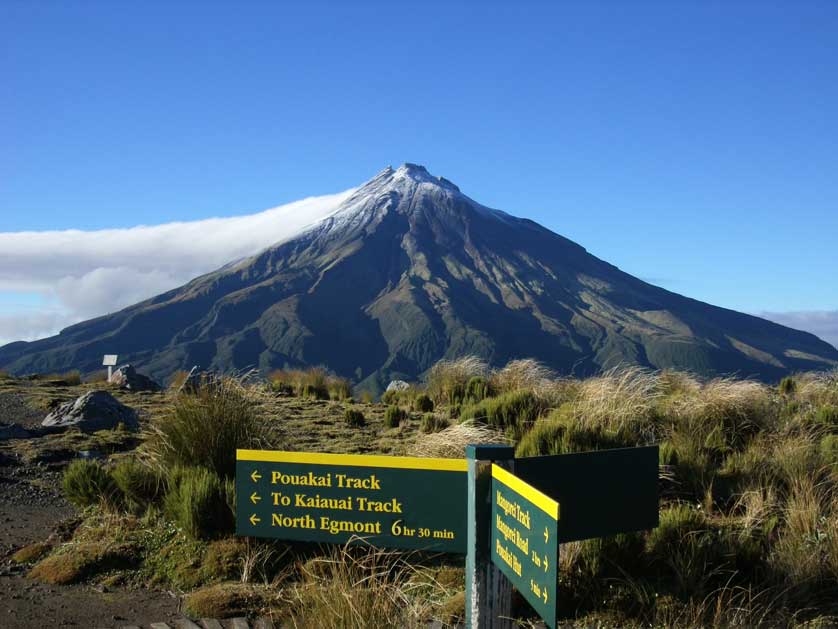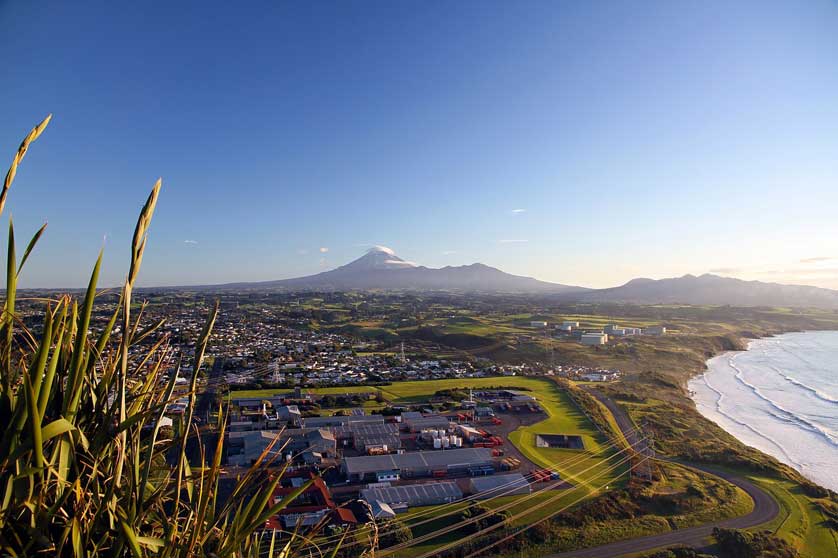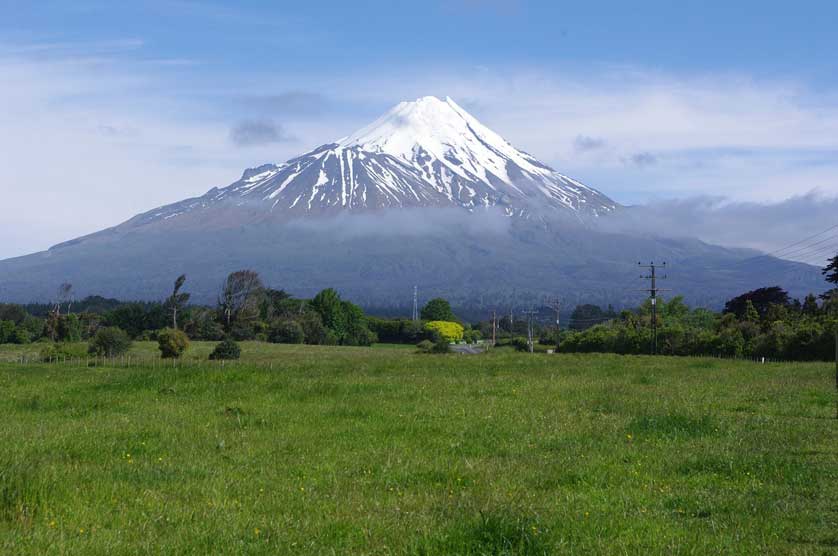Mount Taranaki, Egmont National Park, New Zealand
 |
| Taranaki Maunga; photo by David Stormer |
Mount Taranaki (Taranaki Maunga) is a presently dormant volcano in Egmont National Park. At 2,518 metres (8,261 feet) Taranaki is the second highest mountain in the North Island, after Mount Ruapehu. Captain Cook named the mountain, "Mount Egmont" but this was changed to its Maori name in 1986 and becoming 'Taranaki Maunga' in 2025.
The mountain is the centerpiece of the Egmont/Taranaki national park. It is an active, though presently dormant, stratovolcano with a perfectly symmetrical cone-shaped peak.
The last major eruption was in 1655 with minor activity in 1854.
Hiking to the summit is a popular activity for experienced climbers, but there are also many well-marked trails of varying difficulties for visitors to enjoy. Due to its resemblance to Mount Fuji in Japan, Taranaki provided the backdrop for the 2003 film The Last Samurai, starring Tom Cruise.
 |
| Taranaki from the Pouakai Circuit tramping track |
History
The mountain is estimated to be around 120,000 years old. It stands alone on the Taranaki Peninsula, surrounded by flat, fertile plains. The symmetrical cone is the result of numerous andesitic lava flows and pyroclastic eruptions. The mountain is considered dormant but still active geologically, with future eruptions possible.
The mountain holds deep spiritual significance for Māori, particularly the Taranaki iwi (tribes). According to legend, Taranaki once lived among other mountains (Tongariro, Ruapehu, and Ngauruhoe) in the central North Island. After losing a battle over the beautiful mountain Pihanga, Taranaki fled west, carving out the Whanganui River as he went, and settled in his current location.
The mountain is considered a tapu (sacred place), and Māori ask visitors to treat it with respect. It's customary not to stand on the summit, which is considered the head of the mountain.
 |
| Taranaki Maunga is New Zealand's most perfectly shaped volcano |
In 1770, Captain James Cook sighted the mountain and named it Mount Egmont in honor of John Perceval, the 2nd Earl of Egmont. In 1985, the New Zealand Geographic Board (NZGB) approved a resolution: "That the name of the mountain revert to its original name 'Taranaki' but that the name 'Egmont' be continued as a secondary name in brackets." The following year in 1986, following a decision by the Minister of Lands, the name became 'Mount Taranaki or Mount Egmont.' In April 2025, the name changed again to Taranaki Maunga with Egmont dropped completely.
Te Papa-Kura-o-Taranaki DOC
The Department of Conservation (DOC) Visitor Centre is at 2879 Egmont Road (PO Box 462 New Plymouth 4340). Tel: 06 756 0990; 8.30 am to 4.30 pm daily.
 |
| Mount Taranaki (now Taranaki Maunga since 2025) |
Accommodation in New Plymouth
The 341 square kilometre Egmont National Park and Mount Taranaki lie close to the west coast of the North Island near the town of New Plymouth. New Plymouth offers a variety of accommodation and eating options.
Try The Devon Hotel with a heated outdoor pool and free use of mountain bikes.
The modern Novotel New Plymouth Taranaki has an onsite restaurant and bar.
The Plymouth International provides both air conditioning and cable TV.
Find accommodation in New Plymouth.
Access - Getting There
The fastest and most convenient way to reach New Plymouth from Wellington is by air. You can book a domestic flight from Wellington International Airport (WLG) to New Plymouth Airport (NPL). The flight duration is approximately 45 minutes. From Auckland Airport (AKL) to New Plymouth Airport the flight duration is approximately 1 hour and 15 minutes.
If you prefer to drive, you can take State Highway 1 (SH1) from Wellington to Bulls, then switch to State Highway 3 (SH3) and continue north to New Plymouth. The approximate driving distance is around 355 kilometers (220 miles), and the journey takes about 4.5 to 5 hours, depending on traffic and road conditions. From Auckland take State Highway 1 (SH1) and continue south until you reach State Highway 3 (SH3). Take SH3 towards New Plymouth, the approximate driving distance is around 350 kilometers (220 miles). The journey takes about 4.5 to 5 hours, depending on traffic and road conditions.
Several bus companies operate services between Wellington and New Plymouth. Intercity and Skip Bus are two popular options. The bus journey takes around 6 to 7 hours, depending on the route and stops. It is advisable to check the schedules and book your tickets in advance. The bus from Auckland takes around 6 to 7 hours, depending on the route and stops.
You can also combine a train and bus journey to reach New Plymouth from Wellington. Take the Northern Explorer train from Wellington Railway Station to Palmerston North, and from there, catch a connecting bus to New Plymouth. The total travel time can vary but generally takes around 7 to 8 hours.
 |
| Due to its resemblance to Mount Fuji in Japan, Taranaki provided the backdrop for the 2003 film The Last Samurai |
Books on New Zealand





0 Comments